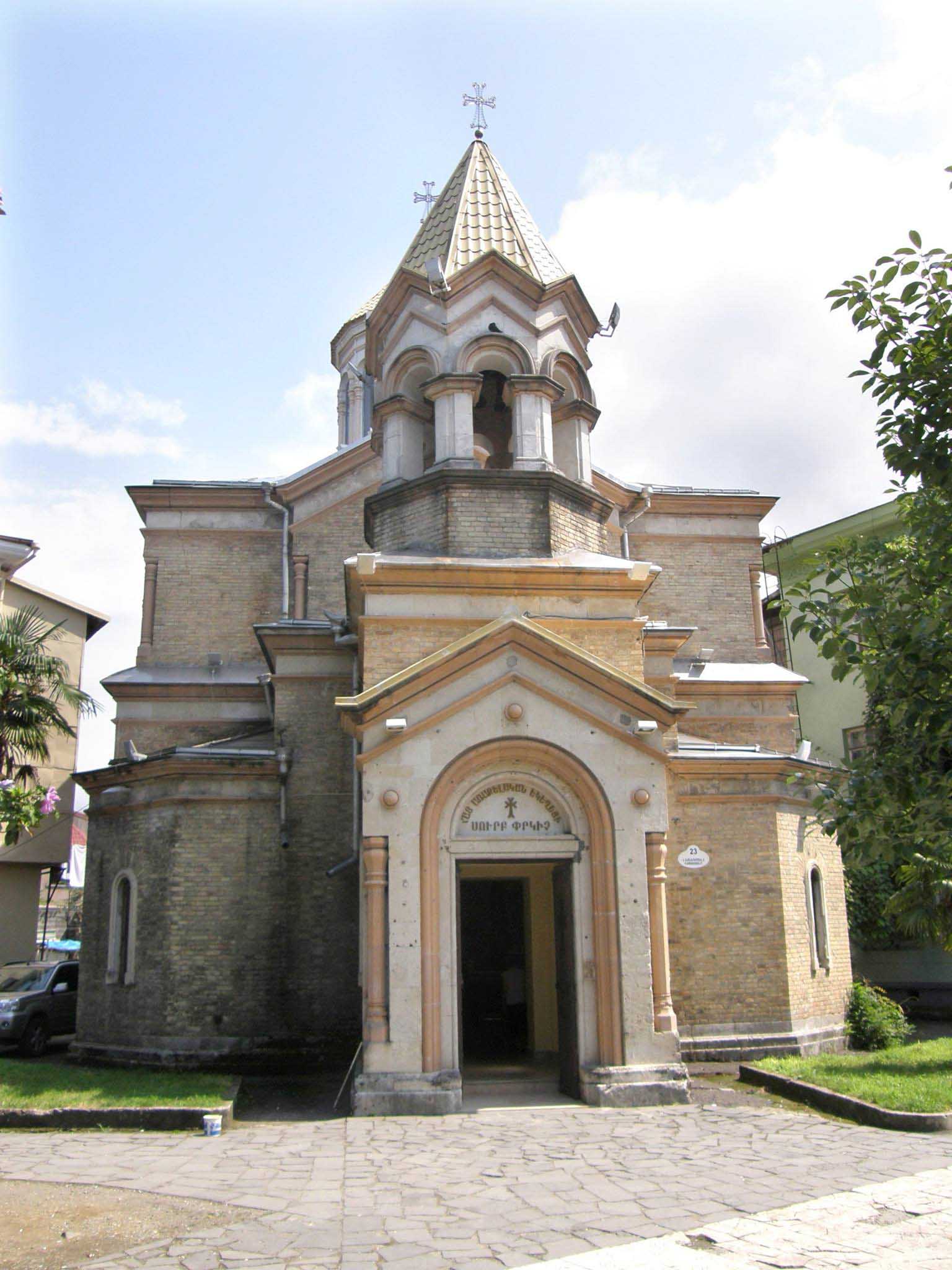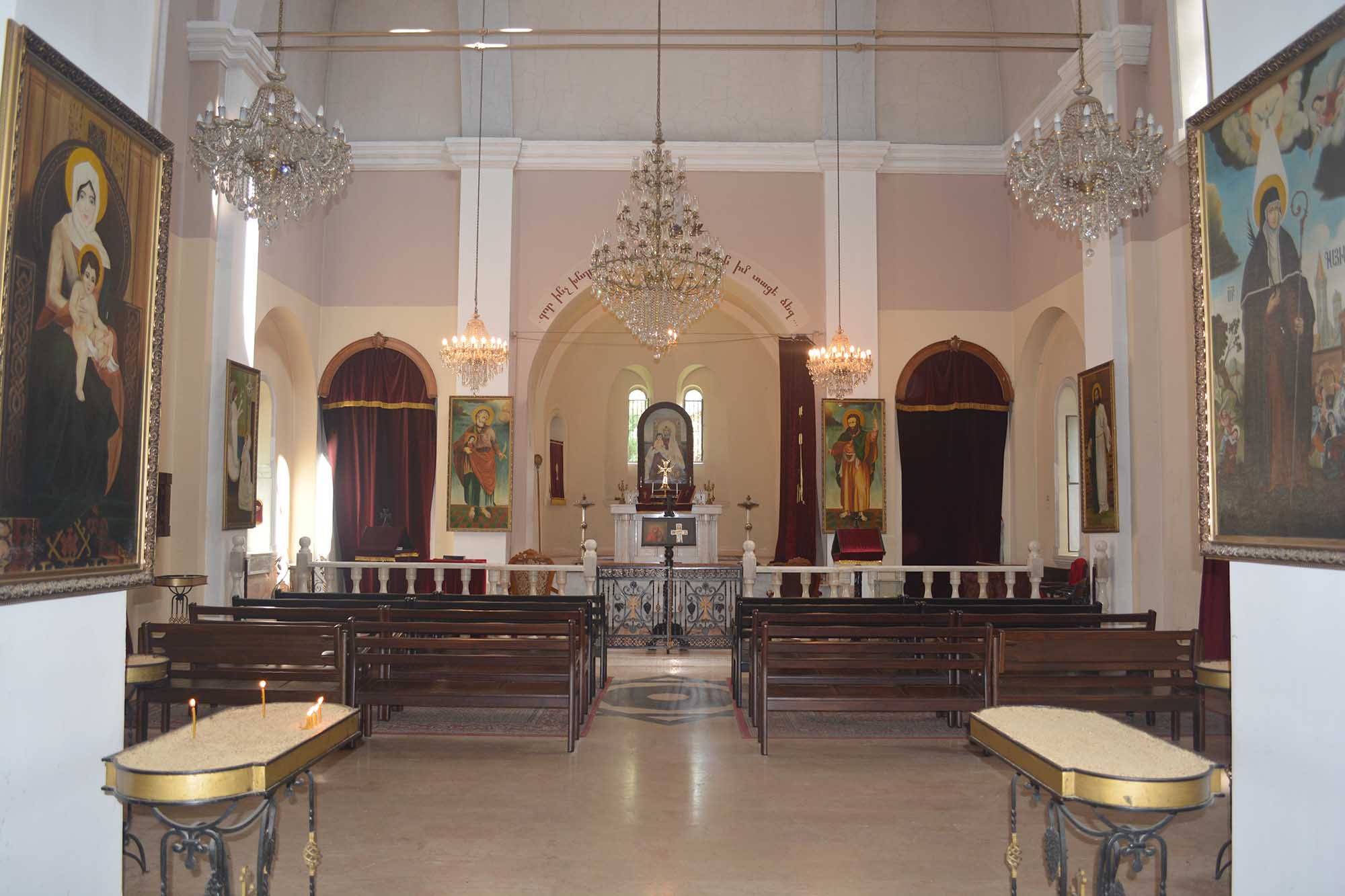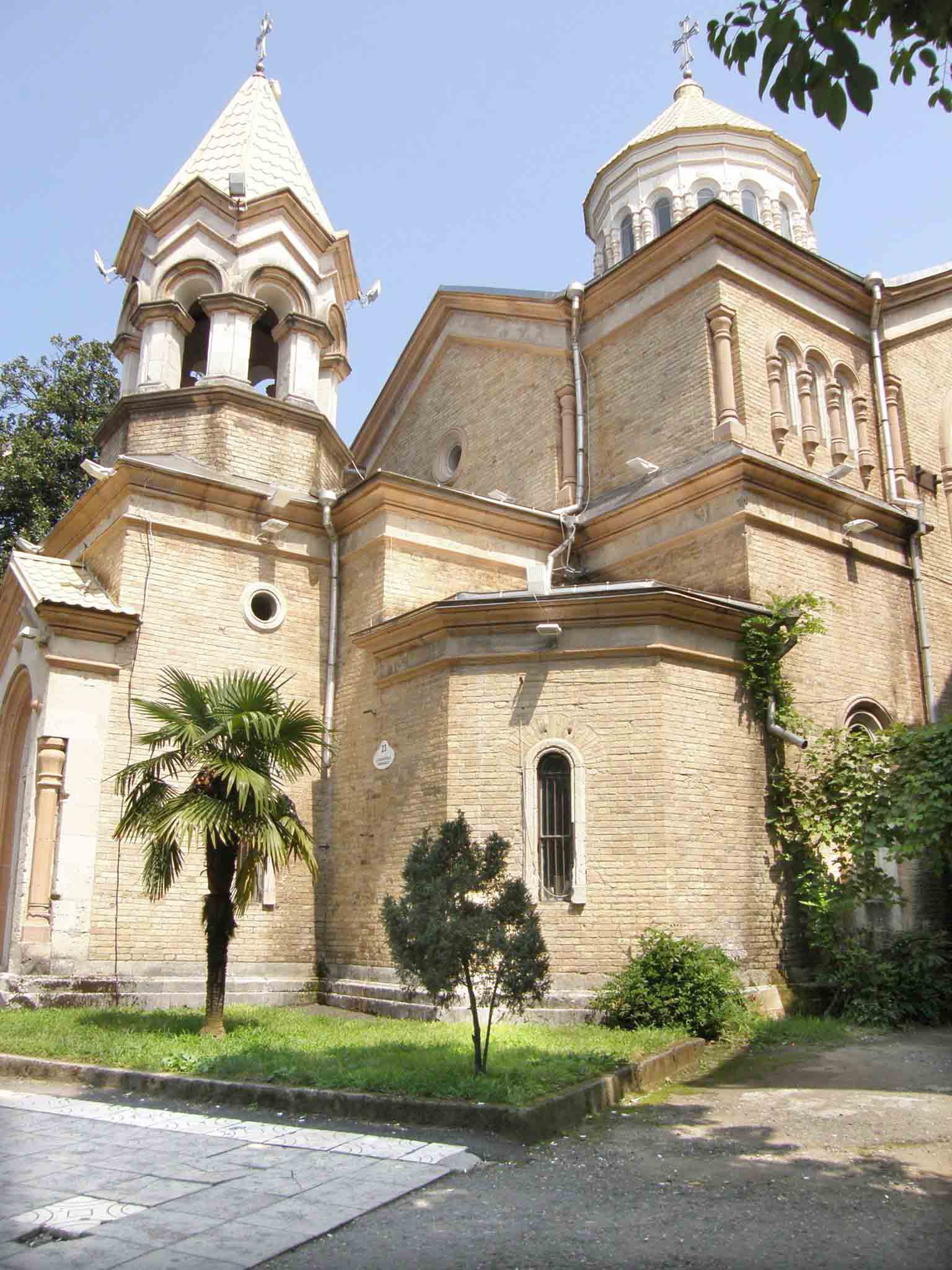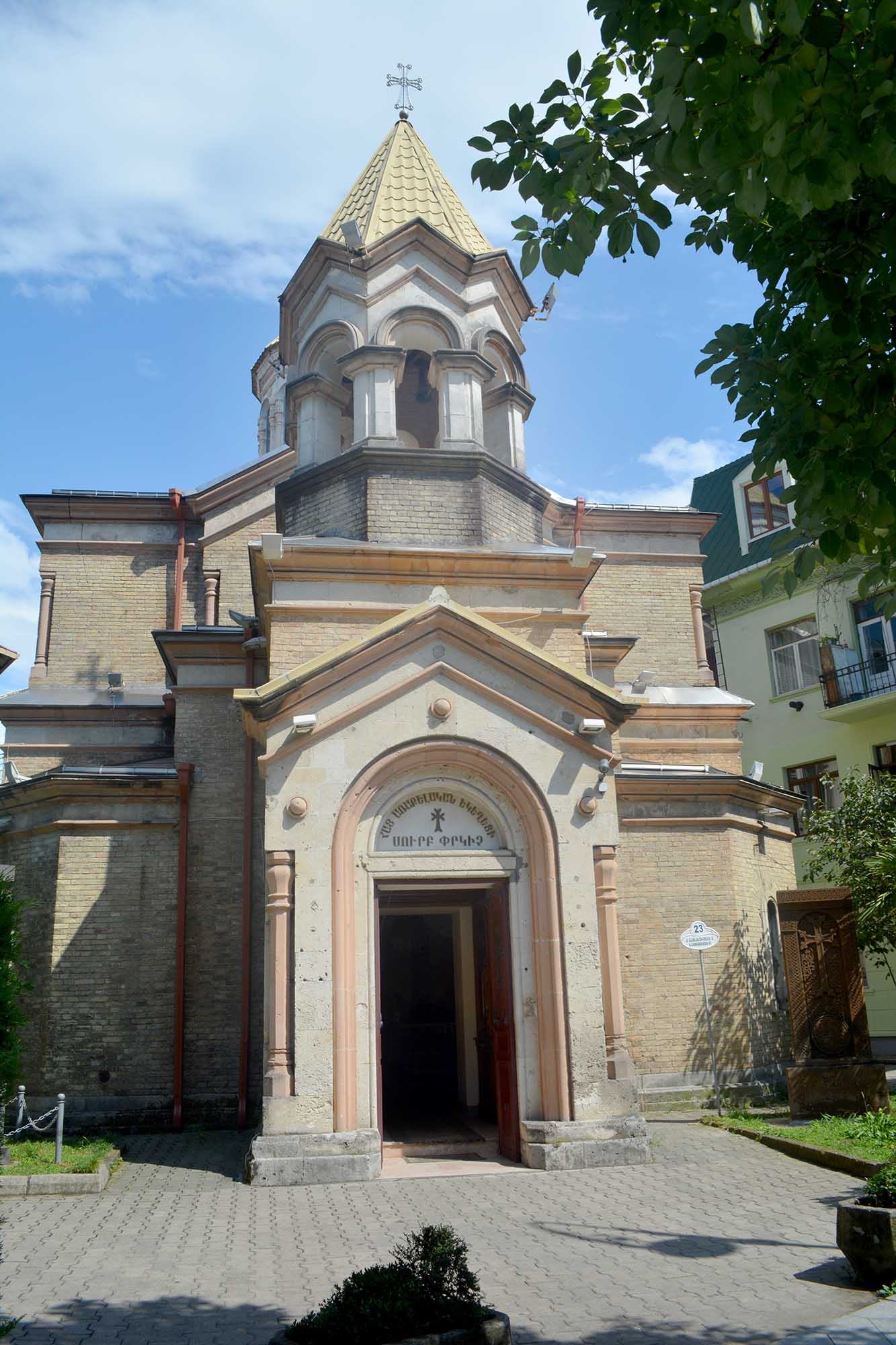BATUMI – SURB PRKICH (SAINT SAVIOR) CHURCH
 THE CHURCH WAS FOUNDED IN 1879 ON THE BASIS OF A WOODEN CHURCH.
THE CHURCH WAS FOUNDED IN 1879 ON THE BASIS OF A WOODEN CHURCH.
IT WAS BUILT IN 1895-1899.
ADDRESS: 39, ZHORDANIA ST., BATUMI CITY
Surb Prkich (Saint Savior) church of the Armenian Apostolic Holy Church was built in 1879 in Batumi with the efforts of priest Rev. Father Konstandin Ter-Stepanyan. The church was originally made of wood [1] but it was destroyed very quickly, and already in 1887 there was a need to build a new church. Several famous public figures, led by the local parish priest Konstandin Ter-Stepanyan, initiated raising funds for the construction of a church. As a result of efforts by Arshak Tsaturyan, Vasil Paremuzyan, Ghazar Ter-Ghazaryan and Arshak Shkhiyants about 400 rubles were collected [2], but due to the lack of financial resources, construction was carried out with big interruptions [3] and it last almost a quarter century.

On December 12, 1900, the Catholicos of All Armenians gave his blessings the newly built church with his Pontifical Encyclical N1330 [9]. An invitation was sent to Catholicos Mkrtich Khrimyan on the occasion of the church consecration ceremony to be held on December 17 of the same year [10].
N1330 [9]. An invitation was sent to Catholicos Mkrtich Khrimyan on the occasion of the church consecration ceremony to be held on December 17 of the same year [10].
Architecture: Surb Prkich church is built of burnt brick, and represents the type of the cross-domed style. The external dimensions are 9,61 x 6,5 m. The artistic and spatial style is cross-shaped. The southern and northern walls are decorated with semicircular decors. Decorative columns are built in the corners of the building; the front part of western part is circular. The church has three entrances: from south, west and north. The central dome is on the east side. The interior walls are plastered and painted. The baptismal font is placed on the left side.
The church during the Soviet era: Surb Prkich church was closed on April 26, 1923: “...today, on the 26th of this month, at about 10 o’clock in the morning, the government sealed Surb Prkich Armenian church. The reason is unknown for the board’’ [11].
From 1930 to 1958 the church building was used as a movie rental warehouse. In 1959, the Soviet authorities decided to demolish the church building under the excuse of “improvement of the city’’. The local Armenian residents organized a petition and addressed a letter-application to Catholicos of All Armenians Vazgen I asking him to intervene and prevent the church from collapsing. Bishop Vahan Kalantaryan and deacon Hovhannnes arrived in Batumi from the Mother See in order to convey the written request of Holy Etchmiadzin to Alexander Tkhiliashvili, Chairman of the Supreme Council of Adjara. The church was closed, and the city authorities demolished only the metal gates of the church. High-rise buildings were built on the church’s right and left sides leaving it in the background. Later, in 1959-1991, it was used as an astrophysical observatory.
Post-Soviet Period: With the participation of Rev. Father Abgar Hovakimyan, spiritual servant of the Armenian Diocese in Georgia, and late Gevorg Sergeyi Avakov, president of the “Renaissance” (Veratsnound) Charitable Union of Armenians in Adjara, on March 3, 1992, by the decision of the Batumi City Administration, the building of the Surb Prkich church was transferred to the “Renaissance” Charitable Union of Armenians in Adjara.[12].
That same year, renovation of the church began, funded by the local Armenian community. The reconstruction efforts intensified between 1996 and 2000. Afterward, the church was reopened and resumed full operation [12]. Rev. Father Abgar Hovakimyan served as the first pastor of the church.
Surb Prkich church in Batumi actively operated from the very first years of leadership of the Primate of the Armenian Diocese in Georgia, His Grace Bishop Vazgen Mirzakhanyan. In 2007, Surb Mesrop Mashtots (Saint Mesrop Mashtots) a Sunday school was opened adjacent to Surb Prkich church in Batumi. In 2009, “Mer apaga’’ (“Our future’’) youth center and in 2012 the “Women’s Union’’ were established adjacent to the church.
In 2015, under the leadership of the Primate of the Armenian Diocese in Georgia, a center for education, culture and youth named after Alexander Mantashyants was opened in Batumi with the financial support of the RA Ministry of Diaspora, Jinishian Memorial Foundation, parish community of Surb Prkich church and the Armenian Diocese in Georgia. The established center is the property of the Armenian Diocese in Georgia, and it aimed at development of national culture and maintenance of Armenian identity among the Armenians in Adjara [13].
Diocese of the Armenian Apostolic Church in Georgia
Armenian Historical and Cultural Heritage Research Center in Georgia
[1] See: S. Karapetyan, Armenian churches in Georgia, Norashen 2006/6, p. 6-7:
[2] See: ‘’Mshak’’, 1887, N 6, p. 1:
[3] See: ‘’Nor-Dar’’, 1889, N 150, p. 3;1890, N 153, p. 3:
[4] See: S. Karapetyan, in the same place
[5] See: ‘’Nor-Dar’’, 1891, N 84, p. 3:
[6] ‘’Nor-Dar’’1895,N 151, p. 3:
[7] See: NAA, ֆ. 56, ց. 1, գ. 9472, թ. 2:
[8] See: ‘’Taraz’’, November 14, 1899, N 43, p. 1004:
[9] NAA, ֆ. 53, ց. 1, գ. 3024, թ. 9:
[10] NAA, ֆ. 56, ց. 18, գ. 264 թ. 142:
[11] NAA, ֆ. 57, ց. 3, գ. 525, թ. 30:
[12] See: S. Karapetyan, in the same place
[13] Press Department of the Armenian Diocese in Georgia
 Հայերեն
Հայերեն  ქართული
ქართული  English
English  Русский
Русский 



